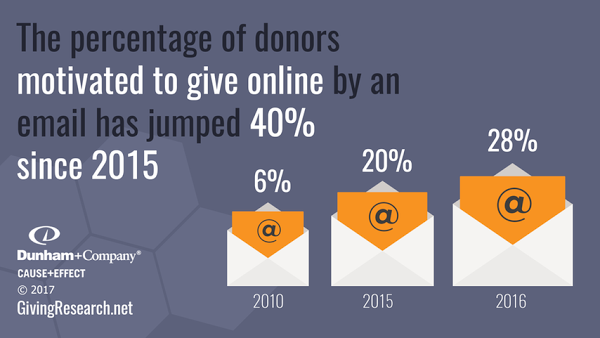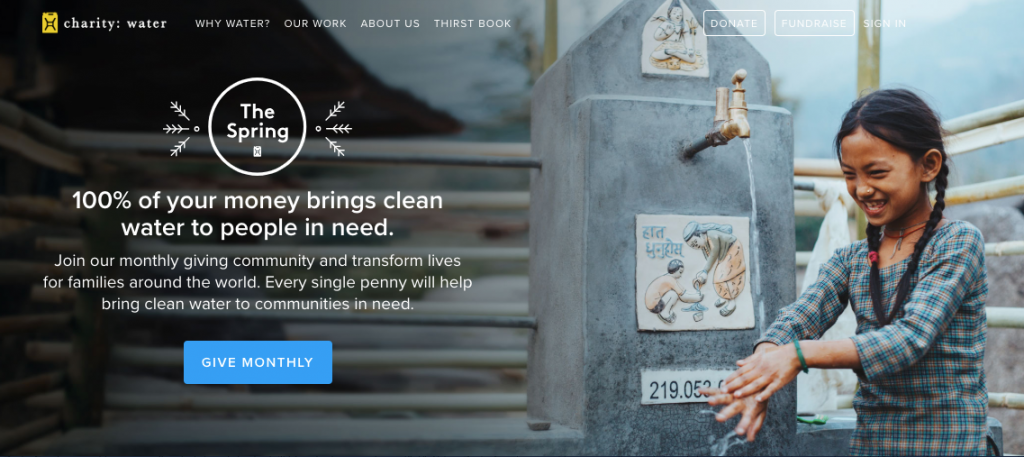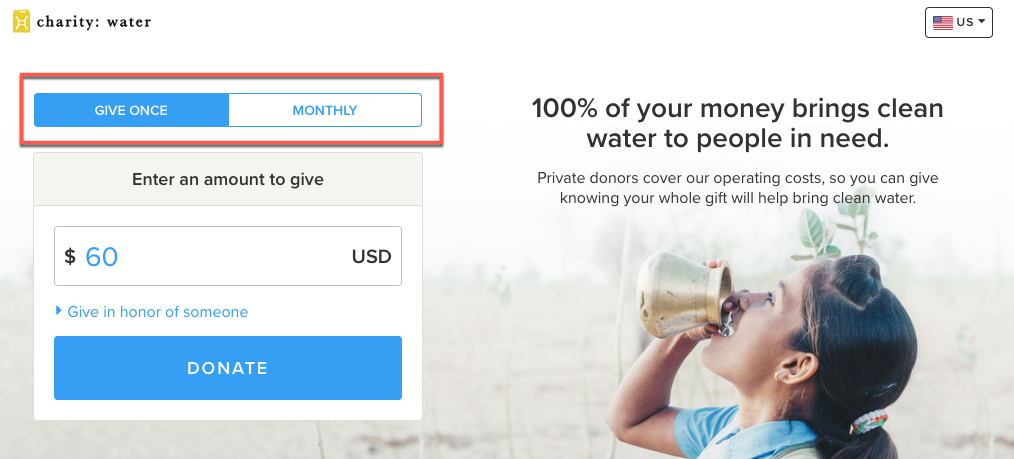Five ways to raise more money in 2019
Technology, media and people’s motivations to donate are constantly changing. This makes it challenging for non-profits because they need to always be preparing and adapting for what’s next.
So in this post we’ll look at five ways to increase donations for your non-profit in 2019. Hopefully, the tips and advice that follow will help you to create successful fundraising and donor engagement strategies in the year to come.
1. Make use of social media fundraising tools
The number of donors giving via social media channels is growing. Take a look at these stats from the 2018 Global Trends in Giving survey:
- 29% of donors worldwide say that social media is the tool that most inspires them to give
- Of those donors, 56% say that Facebook inspires them the most, 20% say Instagram, and 13% say Twitter
- 18% of donors worldwide have donated to a charitable organisaion directly through Facebook. Of those, 88% say they are likely to give again through Facebook.
So of all social media channels, Facebook dominates, especially because of its new fundraising tools that have transformed global giving.
It also helps that the social media powerhouse has removed charitable fundraising fees, which means that 100% of money given goes to the charity.
So what should you do next?
Get familiarised with Facebook’s fundraising tools and donation options and start using them to raise more money for your non-profit.
At the same time, use Facebook’s other tools to create visibility for your cause and encourage more people to donate. This includes Facebook Live, sharing of videos and Facebook Ads campaigns.
If your non-profit also has an engaged audience on Instagram, make sure your fans know that you accept donations. For example, you could change the link in your Instagram bio to your donation page and encourage followers to click on it by writing “click the link in bio” in your captions.
You can also run an ad campaign on Instagram. In fact, since Instagram’s sponsored posts are managed via the Facebook Ad platform, you can target a similar audience, which saves you time.
Here are two guides and a free course to help get you started:
- Everything you need to know about Facebook Live
- Getting started with your first Facebook Ads campaign
- A beginner’s guide to Instagram advertising
While these resources are directed at businesses, there’s lots of useful advice that you can easily apply to your organisation, too.
2. Grow your email list
The same 2018 Global Trends in Giving survey also revealed that for 27% of donors worldwide, email is the second tool that inspired them to give, after social media.
Another study done by Dunham & company found that the percentage of donors motivated to give online by an email jumped 40% since 2015.

What does this mean? It means that email is yet again a trusted source of communication and that people have begun to trust email as a part of their charitable endeavours.
In other words, it’s time to put more effort into growing your list and nurturing your subscribers. How?
- Use these five techniques to entice more people to subscribe to your mailing list.
- Communicate with them regularly. Find out what they read, what they’re interested in, what their passion is. Then send them articles, videos and stories based on those interests. Make it a goal not only to attain a higher level of funding from them, but a superb relationship. Check out these seven types of emails that your non-profit should be sending to your subscribers to keep them informed and connected to your organisation.
- Always thank your donors, especially after they make a donation. This is something that you can easily automate when you’re using our 123 Reg email marketing service.
3. Use more video
You’ve probably already seen the stats but in case you haven’t, here are a few of the most powerful ones:
- Video will make up 82% of consumer online traffic by 2022 (Source)
- Social video generates 1200% more shares than text and image content combined (Source)
- Video on a landing page can increase conversions by 80% or more (Source)
- 51% of marketing professionals worldwide name video as the type of content with the best ROI (Source)
What does this mean for your non-profit? It means that there’s a significant increase in video engagement that your non-profit should take advantage of.
Now, while many non-profits are aware that video marketing can be a huge asset for their organisation, and while they’re excited at the prospect of integrating more video into their communications and fundraising efforts, they’re also sceptical.
The most common reasons are: making videos is too expensive, they take too much time to create, it might not get them the results they want.
Sure, creating video content is resource-intensive and there’s no guarantee they’ll work to achieve your goals, but the solution isn’t to not create video. It’s to do it with purpose and to make the most of every video you create.
Here are a few types of videos you can create, along with a few examples:
Share your mission. Tell people the story of your organisation or cause with a quick video.
Explain your cause. Use video to help people become aware, understand and put a face to your cause.
Inspire action. Create a short video with a strong call-to-action to get your existing supporters to do more for your cause.
Highlight your impact. Celebrate your non-profit’s success and show donors the progress you’re making and how their money is used.
Robin Hood Relief Fund: Hurricane Sandy from Robin Hood on Vimeo.
Tell a story. Get people’s attention on your cause with a powerful story.
4. Encourage recurring giving
There was a significant increase in recurring monthly donations in the past few years and that trend is continuing into 2019. So if you don’t have a monthly or a recurring giving option on your donation page, now’s the time to create one.
Why is this a must-develop strategy in 2019?
Because recurring donors can give over five times more to your organisation over their lifetime, and they’re also more likely to keep giving year after year.
In fact, the Fundraising Effectiveness Project report found that monthly recurring donors have a 90% retention rate, compared to the average donor retention rate of 46%.

Just imagine no longer having to worry about the seasonal drops in donations and being able to count on a reliable stream of monthly revenue. Developing a recurring giving programme can help do that for you.
Here’s an example from charity:water where they encourage visitors to donate monthly directly on the homepage:

Notice how the copy makes it feel like you’re joining an exclusive group or community, which is a fantastic tactic to encourage donations.
If you go the Donate page, you’re given two options: to give once or monthly.

You’ll find lots of actionable advice on how to encourage recurring donations in these articles:
- 3 tips to running a wildly successful recurring donation campaign
- How to attract and keep more monthly donors
- If you want more money, stop asking for it!
5. Improve your donation page
It’s hard enough for a non-profit to rise above all the noise and get its message out there. If you’ve managed to get potential donors to visit your site, you’d better make sure that you give them the information they want and that you make the donation process as quick and as pleasant as possible.
If a donation page is cluttered, difficult to navigate, or confusing, or if there are other usability issues like an unclear message, broken links, nonexistent or difficult to find “donate” call-to-action buttons, then it defeats its own purpose: increasing donations.
So take a close look at your donation page and make sure:
- It’s easy to find from your homepage and all other pages
- The donation button is clearly visible and leading to the donation page
- It includes a compelling message that inspires or motivates people to donate
- It’s customised and branded
- It Includes one-time and monthly giving options
- It offers a variety of payment options
- It works properly on all devices – mobile phones, tables and PCs.
Wrapping up
Understanding how media and donor’s behaviour and motivations change can give you an advantage that you can use to get more people to support your cause. So test out the tips and advice above to create a winning fundraising strategy for your non-profit in 2019.
